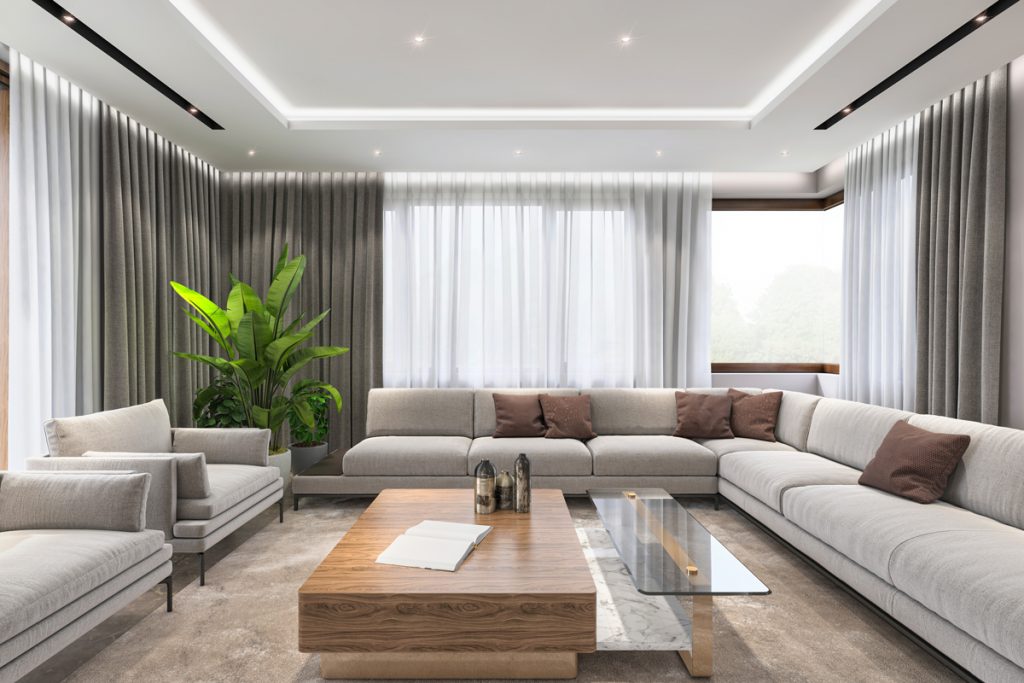Keeping heat inside your house is essential, especially in the fall and winter months. It's common to find as many ways as possible to inexpensively regulate the temperature in your home. Many homeowners often wonder if curtains provide any insulation. We've done the research to bring the answer to you.
Curtains absolutely do provide insulation, but only if they’re properly installed and fitted for their windows. Thermal/insulated curtains work the best for this purpose, and you can either buy them or make them at home.
But how do curtains provide insulation? How can you make your own insulated/thermal curtains at home? Why are insulated/thermal curtains so effective at keeping a room appropriately warm or cool? Stick around and keep reading to find out the answers to all these questions and more.

How Curtains Provide Insulation

Good curtains stop cold air from entering your home by creating an air gap between the room and the window. Ideally, they also prevent any flow of hot and cold air which would create a draft.
To illustrate this occurrence, imagine you have a simple set of curtains held on a track about 1-1/2” away from the wall and whose bottom is several inches above the floor. In this example, there’s nothing covering the curtain’s top.
For this scenario, the air between the curtain and the window will get cold during cooler weather since some heat will escape through the glass. The cold air will flow under the curtain, creating a chilly draft, and the warm air will flow down from the ceiling into the space between the curtain and the window. Air behaves this way because it wants to have a uniform temperature, so the presence of cold air makes the warm air flow behind the curtain and, in turn, becomes cooled.
Thankfully, there are some simple fixes to prevent warm air from escaping so easily. You can begin by installing a pelmet, which is a cornice or valance that covers the top of the curtain rail and stops warm air from being pulled down behind the curtain. Make sure your pelmet covers the top 2 inches of the curtain.
You can also buy a floor-length curtain that prevents cold air from escaping under the bottom. Be sure to purchase enough fabric to allow substantial overlap in the middle of the window since this will prevent warm air from escaping there as well. Finally, let your curtains hang close to and wider than the window frame so they cover the edges.
Do Thermal Curtains Really Make A Difference?
If you spend much time searching for curtains, you’ll come across the terms “insulated curtains,” “thermal curtains,” and “blackout curtains” frequently. Insulated curtains and thermal curtains are two names for the same thing: a four-layered curtain made specifically to keep a room warm, dry, and soundproof.
Thermal curtains go a long way toward improving your windows’ energy efficiency. They can reduce heat loss by 25% in the winter and reduce solar gain by 33% in the summer. If your windows don’t gain and lose heat so easily, you’ll use your thermostat less often, which will save you some money on utility bills. As a side benefit, thermal curtains also dampen sound in the room.
Thermal Curtain Construction
The four layers begin with a decorative outer layer made of a pleasant material like cotton, polyester, linen, wool, or silk. The next layer is made of a thermally resistant material like foam, felt, thick cotton batting, or flannel. The third layer, called the backing, protects the decorative layer from sunlight by reflecting heat and light, which keeps the room cool during the summer. It’s usually made of cotton, reflective film, vinyl, or other materials. The fourth layer, the vapor barrier, protects against moisture.
Some insulated curtains even have a magnetic strip along their edges which is attracted to its counterpart in the window frame or the nearby walls. The magnets help the curtains stick closer to the wall. Hooks or Velcro are also great options.
Like regular curtains, thermal curtains keep warm air inside during colder months, but they also reflect the sun’s heat back outside during summer. However, if you want to maximize their effectiveness, make sure you choose the right fabric and install several layers so that the curtains can more easily stop cold air from getting inside.
Heavyweight, tightly-woven fabrics are far better than light- or medium-weight fabrics at keeping cold air out of a room. Look for options like velvet, tapestry, tweed, denim, or suede. You can combine a simple, solid-color curtain with a more elaborate patterned option so your drapes look stylish while keeping your living room warm.
What Are Blackout Curtains?
Blackout curtains are made to prevent any light from getting through the fabric. As such, they’re great curtains for when you want to keep a room in darkness. They’re usually not as well-insulated as thermal curtains, but some are made with insulating materials so they can double as thermal curtains. Basically, curtains can be blackout, insulated, or both. We’ll talk about some insulated blackout curtains in the next section.
What Curtains Are Best For Insulation?
Now that we’ve talked about how curtains provide insulation, let’s take a look at some of the best ones on the market today.
Nicetown Blackout Curtains
These are a great choice if you want a set of insulated curtains that will block light just as effectively as sound or cold/hot air. You’d be hard-pressed to find better curtains for keeping the room dark when you’re trying to take a nap. The soft triple weave fabric is also easy to maintain since it’s machine washable.
Keep in mind that the curtains will be much more effective at blocking light from entering the room if you choose a darker color.
Click here to see this product on Amazon.
RHF Sliding Door Insulated Curtains
If you’re looking for a good set of curtains for sliding doors, then these have you covered. They’re another fantastic option for keeping out heat and cold. They’re also great for keeping out light, especially if you buy them in a darker color.
There are a couple of drawbacks to the RHF curtains, however. They need to be washed to get rid of their wrinkles if you buy them brand-new, so it’s a good thing they’re machine-washable and machine-dryable. They also aren’t as good at soundproofing a room as other curtains are.
Click here to see this product on Amazon.
How Do You Insulate Curtains?
As we’ve already demonstrated, there are plenty of great insulated curtains available for purchase today. However, if you want to save some money or if you’re just a DIY-type of person, you can make your own insulated curtains at home.
We’ll take a look at two ways to make insulated curtains. One method works if you want to finish your curtains quickly and the other takes longer but gives the end result a nice, professional-quality look.
Method 1
Start by measuring the height and width of the window you’re making the curtains for. Then, measure and cut all four of the fabric layers that will make up the curtain. Cut your curtains at least 10 inches wider and 6 inches taller than the window so that when the curtains are closed, they overlap each other.
Cut every layer in half, top to bottom, so you have two pieces of each. Now, make two separate stacks, both with one of the two pieces of each layer. Fold each edge of the stacks over by ½” on the side that will face the wall and press on the folded edge with an iron. Insert some sewing pins 6” apart all along the edges to temporarily hold them in place.
Next, use a sewing machine to stitch the edges you just pinned, making sure you stitch all four sides for both stacks. Install a set of curtain rod brackets above the window and string some curtain rod clip rings onto your curtain rod. Mount the curtain rod onto the brackets, and finish by clipping the curtains to the rings. Now you’re finished! Like we said before, this method works if you’d rather get your insulated curtains done quickly.
Method 2
If you have more time on your hands and you want your homemade curtains to look as professional as if you’d bought them from your local home decor store, then you can try the method demonstrated in this video series. The overall process resembles the one we’ve just described, but it’s more elaborate and spends more time on each step to create that professional appearance:
In Closing
A good set of properly-installed, insulated curtains can be a big help when it comes to keeping your house appropriately warm or cool as the seasons demand. They can also save you some money on your electric bills by doing some of the heating and cooling that would normally depend upon your thermostat. Whether you buy a set of thermal curtains or make some for yourself at home, you can look forward to more consistent temperatures in your house. Good luck!
Before you go, be sure to check out other helpful guides on HVACseer.com!


